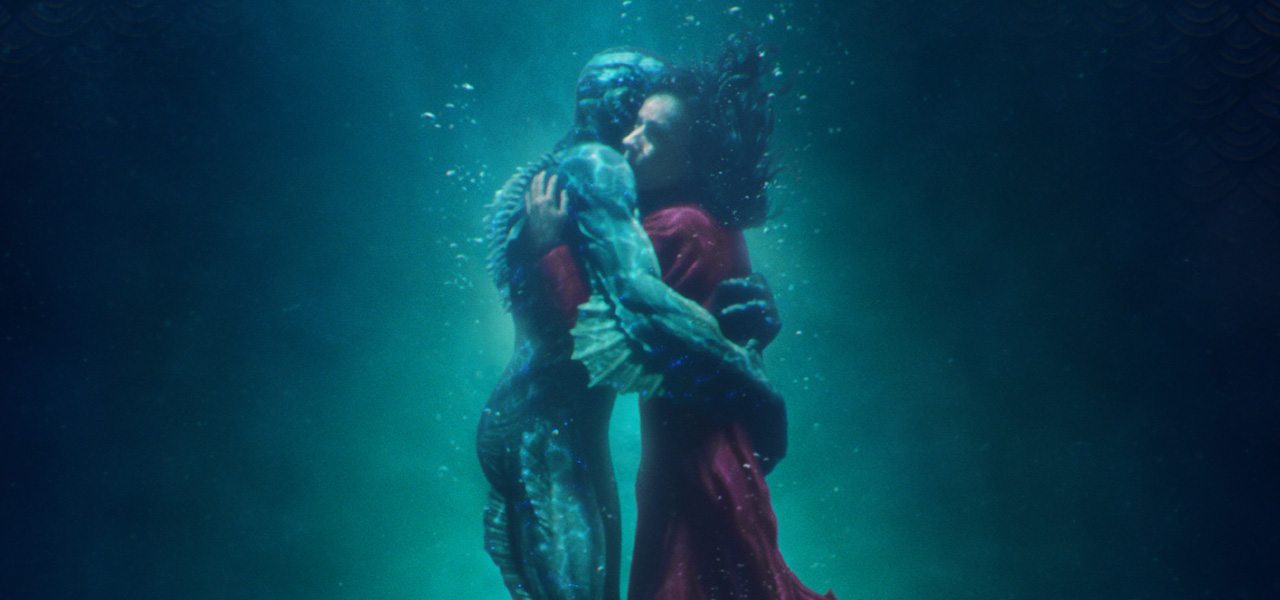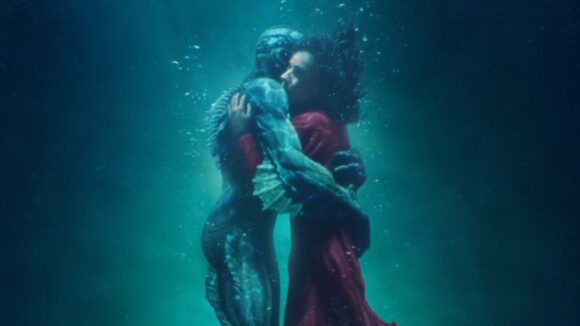

The 3 Effects Techniques Guillermo del Toro Used In ‘The Shape of Water’ To Create A Convincing Character
Guillermo del Toro’s The Shape of Water has already been widely praised for its remarkable portrayal of a love story between an underwater creature and a mute custodian of the government lab that holds the strange being.
Also receiving praise is the director’s combination of several visual effects techniques in bringing scenes with the creature, known as The Asset, to life. These included crafting a practical suit to be worn on set by actor Doug Jones, the cg augmentation of that suit, and relying on a filming technique called dry-for-wet for underwater shots.
Cartoon Brew asked practical effects studio Legacy Effects and digital visual effects studio Mr. X more about their roles in coming up with these effects solutions.
1. Made to suit
Doug Jones is a prolific suit performer (he’s behind characters in Hellboy, Pan’s Labyrinth, and Star Trek: Discovery, among many others). For The Shape of Water, Legacy Effects, working from original designs by lead creature designer and sculptor Mike Hill, created a range of prosthetic suit pieces for Jones to wear on set, as well as head and face make-up effects, to give him an aquatic feel.
But the plan was always to augment the practical suit and make-up effects via digital means. This included the eyes; practical ones were manufactured but ultimately replaced. Moving gill-like structures were also added later as well as some of the bioluminescence of the character.
“Dennis Berardi at Mr. X, and his team, did all of those flourishes, and then they ended up adding things as well,” said Legacy’s Shane Mahan. “They added tremendous life to the final product.”

For many years, practical effects crews and digital visual effects teams have been working hand-in-hand to create the final product. This year, films like Pirates of the Caribbean: Dead Men Tell No Tales and Alien: Covenant featured heavy practical effects work that was either augmented or taken over by cg. The benefit, of course, is to have something on set for the actors to interact with (including Sally Hawkins who plays the mute custodian Elisa in The Shape of Water), for lighting reference, and, in the case of The Asset, to have a strong performance from a very competent actor as the basis of the final character.
Mahan says, too, that any notion that there is some kind of war between the two effects disciplines is not at all the case. “I consider us a branch of visual effects, just that we’re physical visual effects, not digital. But when you take the two and you put them in the same palette, and you start doing things in which the audience can’t quite figure out what it is, or how it’s working, then you’ve created something magical.”

2. Digital make-up
Mr. X was behind several shots of a fully digital Asset, but some of its toughest work was tracking and augmenting the practical effects. Luckily, the studio had been able to work together with Legacy Effects during the design and building of the suit. “I would get updates from Shane,” outlined Mr. X visual effects supervisor Dennis Berardi. “He’d say, ‘Here’s what this sculpt looks like, and this is what the paint is looking like. What do think?,’ and I would have input, which was fantastic, to be able to have input on the design side.”
“We’d then get these beautiful performances from Doug on set,” added Berardi, “and then we would replace only what maybe wasn’t fully realized, or was difficult for Doug to achieve. It became pretty apparent, and even in the early screen tests, that he wasn’t in all circumstances going to be able to deliver the facial performance that Guillermo was after.”
This meant that Mr. X’s artists carried out what was kind of a ‘digital make-up’ approach to augmenting the suit, pushing and pulling some of the prosthetics or replacing parts of the suit and face to score extra emotion. One of the things that helped was a very accurate scan of Jones himself, achieved with the studio’s proprietary photogrammetry scanning rig called Xscan. It consisted of 56 cameras that surrounded the actor and produced textures and geometry.

Still, drawing upon Jones’ original performance, as well as extra shapes and reference captured in addition, was a significant amount of work for Mr. X’s animators. This was especially the case with del Toro looking to ensure any cg work closely matched the on-set footage.
“Digital make-up is by far the hardest thing I’ve ever had to do,” said Mr. X animation supervisor Kevin Scott. “Guillermo wanted a side-by-side comparison in dailies where we’d toggle back and forth between the plate photography and the cg. That’s why we ended up having to build in extra controls to sort of morph into what was more represented on the day of the shoot, because sometimes the prosthetics were slightly different each day. It was very, very scrutinized.”

3. Shooting dry-for-wet
The third major effects technique that del Toro took advantage of was dry-for-wet shooting. This is effectively where action that needed to be underwater was actually filmed without water at all, but instead simulated to look underwater via lighting, atmosphere, and some visual effects augmentation.
For example, the opening shot of the film begins on a riverbed underwater (which was a digital creation by Mr. X). The camera then pushes into a hallway of an apartment and eventually a room where just about everything is floating. Elisa is there on a floating couch before it is revealed she has been dreaming.

“A lot of research went into how to shoot the apartment, and have Elisa in the shot,” said Berardi. “We talked about, ‘Let’s just do a greenscreen, and everything will be digital,’ but we realized that Guillermo likes to build sets. Dan Lausten, the cinematographer, then had this idea to use dry-for-wet. The apartment was there anyway, because half the movie takes place in her apartment, and so we did some testing.”
That testing resulted in a technique that relied on powerful overhead projectors that ran a pre-rendered high contrast animated black and white pattern. It had the effect of looking like the kind of caustic lighting that appears underwater, “like rays of light that are refracted by the surface of the water, which bend and hit objects and spread,” said Berardi.

The set was also filled with smoke and certain props and set pieces hung on monofilaments to make them appear to be floating. Mr. X, in addition to crafting that entirely digital opening section of the shot, then added particulate, bubbles, and fish into the apartment set for the remainder of the scene. Elisa’s hair and the blanket that floats down on her was digital, to provide that underwater look.
“The cadence of the hair movement needed to kind of match the performance and the cadence of the reeds from the riverbed at the beginning of the shot,” said Berardi, who gives credit to many different departments for making the shot work, from the art department to stunts. “We got it in probably five or six takes. It was one of those days where it makes you proud to be part of a team.”


.png)